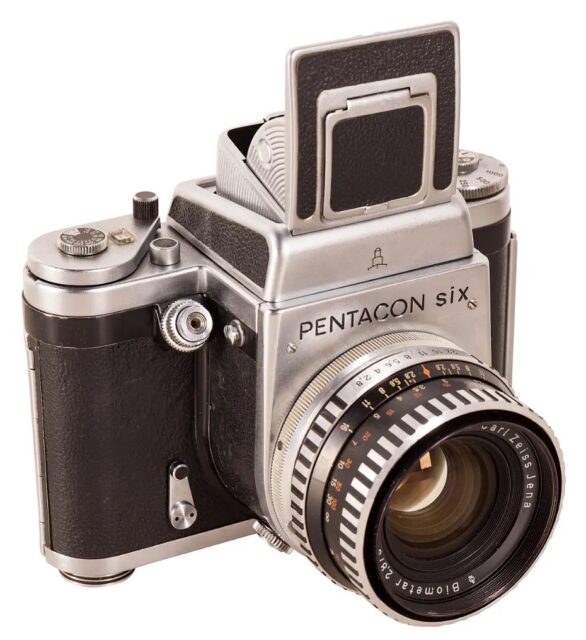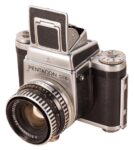Announced
Production status
Praktisix/Pentacon six system cameras
Pentacon six
Medium format MF film SLR camera • Discontinued
Specification
| Format: | |
| Medium format 6x6 | |
Film type: | 120 roll film |
| 220 roll film | |
| Praktisix (Pentacon Six) [74mm] | |
| Shutter: | |
Type: | Focal-plane |
Model: | Mechanical |
Speeds: | 1 - 1/1000 + B |
| Exposure: | |
Exposure metering: | None |
Exposure modes: | Manual |
| Physical characteristics: | |
Weight: | <No data> |
Dimensions: | 168x125x130mm |
Manufacturer description #1
THE ULTIMATE IN 2 1/4" SQUARE PHOTOGRAPHY
- Zeiss 80 mm f2.8 biometar lens - with a range of Zeiss lenses from 50 mm to 1,000 mm
- 12/24 exposures on 120/220 film
- 35 mm speed of operation with rapid lever wind
- Pin sharp 2 1/4" square negatives
- Comprehensive range of accessories
This is the Pentacon Six - the camera which makes you master of any situation. The ideal camera for the professional or advanced amateur photographer. Just one look through the brilliant reflex screen and you will understand just why the Pentacon Six is the most exciting camera to appear on the market for many years. The Pentacon Six is the camera for the photographer who demands the ultimate in precision and flexibility.
JUST LOOK AT THE SPECIFICATION! 12 exposures on 120 film or 24 on 220 film providing a large negative and professional size colour transparencies. Lenses from Zeiss and Meyer are available to cover all your needs from 50 mm to 1,000 mm focal length. The single stroke lever wind, a range of shutter speeds from 1 sec to 1/1,000th of a second and the superb pentaprism* viewfinder provide in addition a speed of use comparable to that of the highest quality 35 mm cameras.
* optional extra
Manufacturer description #2
PENTACONsix, the only 2 1/4 inch square format SLR of the world that features TTL exposure control by the unique "light concentrator" system
Besides free interchangeability between eye-level finder, waist-level finder and grounglass hood with magnifier we are now offering the PENTACON TTL METER/FINDER SYSTEM with LIGHT CONCENTRATOR. This system turns your PENTACON six into a full-fledged TTL SLR with high accuracy in exposure control. Professionals and serious amateurs alike will be able to appreciate and judge this added advantage hitherto unknown in 2 1/4 inch square format SLR's. Check also the other features:
The popular 2 1/4 inch square format with a 400% greater film area than any 35 mm SLR, the unique interchangeable finder system of a true SLR, the fast focal plane shutter with speeds up to 1/1000th sec, interchangeable lenses from 50 mm wideangle to 1000 mm telephoto, free choice between 12 exposures on 120 film or 24 exposures on 220 film, as well as a big choice of accessories for special applications. And last not least PENTACON six is the lightest camera of its class which certainly is good news for the "loaded down" photographer.
Manufacturer description #3
PENTACONsix
Genuine single-lens 6 x 6 cm reflex camera
For 24 frames on 220 roll film or 12 exposures on 120 roll film - focal-plane shutter with speeds between 1 sec. and 1/1000 sec., and B - interchangeable finder system (finder hood, PENTA prism, focusing magnifier) - locking devices for flash socket, shutter release, and finder hood - shutter-cocking mechanism automatically locked after the 12th and 24th frame, resp. - interchangeable lenses with focal lengths from 50 mm to 1,000 mm, up to 300 mm with fully automatic diaphragm setting - accessories for viewing the image: interchangeable field lenses, angle finder, focusing telescope, eye cup, mount for corrective lenses; accessories for photomicrography: close-up bellows attachment, intermediate rings and rings provided with plunger movement, special intermediate rings with twin-wire release, reversing ring, universal tripod, focusing slide, special pressure plate-accessory clip.
Intended use: The PENTACONsix is the camera used with high success by all photographers who will not miss the universal adaptability of the genuine single-lens camera which meets highest demands with respect to depth of sharpness and brilliancy.
Particular features: 24 frames in the 6 x 6 cm size without change of film - absolutely-reliable film transport owing to a feeling measuring shaft - low weight - among the cameras of equal quality, the PENTACONsix is that of the lowest mess.
From the British Journal of Photography (March 22, 1968)
This camera is an improved model of the well-known Praktisix roll film single lens reflex camera. There were two Praktisix models, the Praktisix and the Praktisix II. The earlist model was criticised by some users on shutter performance and film transport, and the second model incorporated a number of improvements in the shutter and transport mechanisms. Now the Pentacon Six has arrived, which incorporates further improvements, mainly in controls and styling, and the new name gives the camera a fresh start.
The overall appearance of the Pentacon Six has been considerably improved by the superior quality silver chrome finish, and greater attention paid to minor details in styling. Various controls have parts picked out in black or covered with small inset panels of black covering material. These small points build up to make for a greatly enhanced appearance of the camera body.
It should be emphasised that the Pentacon Six is a new camera, and the decision to give it a new name must be accounted entirely valid, although the same die-casting is used. The design has been tightened up; the camera now ranks fully professional in layout and mechanism.
The styling of the 80 mm f/2.8 Biometar has been improved, and the focusing ring, which is on the front rim of the lens, is now in metal, broader and with wide milling to give a firm grip. The aperture setting ring has similarly been enlarged, also making for a much speedier grip and firmer control than the previous design.
The Pentacon Six is fully up to date optically, and functionally, and makes a most important contribution to advanced amateur and professional photography. It is the type of camera which will wean people away from 35 mm, by showing them the advantages of the larger format, whilst still retaining much of the feel and appeal of the 35 mm camera.
From the Amateur Photography magazine (January 24, 1968)
The Praktisix II was very similar to the present Pentacon Six. However, the latter can take 220 film (the double-length 120), and has some minor but useful modifications. In particular the general quality seems higher, the lens performance is better, the shutter and film transport proved more reliable, and the finish, especially in the chrome, is of a higher standard.
A cloth focal-plane shutter is used, with speeds from 1 to 1/1000th second plus B and also an X setting at about 1/25th. Delayed action is by a completely separate mechanism, giving up to about 12 seconds delay.
The usual method of viewing the image is with a folding waistlevel hood, fitted with magnifier, onto a plain screen with a lens top. Five other screens are made for the Pentacon Six, including one with a central rangefinder spot. The entire hood is removable, and can be replaced with a magnifying viewer or a pentaprism.
Many minor features are fitted, as one expects in a good-quality camera of this class. Film reminders, a locking body release threaded for cable, a locking coaxial socket, a centrally placed tripod bush, a self resetting counter, and sports finder in the hood, are examples.
From the editor
The changes in this first camera after the unification of the East German photo industry into VEB Pentacon show only a few external signs. The primary change is the name plate engraving and the Pentacon symbol on the waist level finder. These cameras have a rod with tiny teeth to control film spacing, while not foolproof they are better than the Praktisixes in this regard. Some time during production a second locking PC socket was added for FP flashbulbs.
The dimensions are indicated for the camera body including the Carl Zeiss Jena Biometar 80/2.8 standard lens.
Similar cameras (3)
Medium format • Manual focus • Film • Singe-lens reflex • Praktisix (Pentacon Six) mount
| Model | Shutter | Metering | Modes | Year |
|---|---|---|---|---|
| Exakta 66 | M, 1/1000 | -- | M | 1984 ● |
| Kiev-60 TTL aka Киев-60 TTL |
M, 1/1000 | -- | M | 1984 ● |
| Kiev-6S [TTL] aka Киев-6С [TTL] |
M, 1/1000 | -- | M | 1971 ● |

